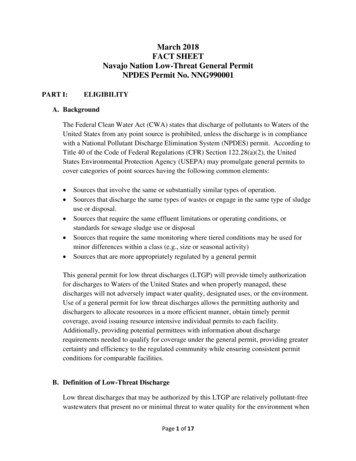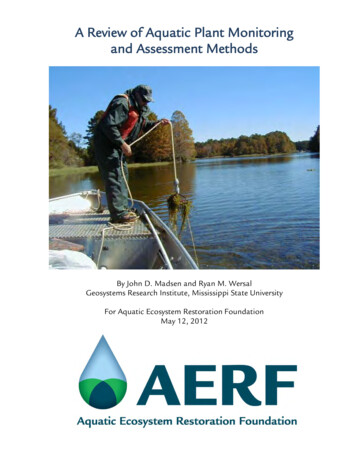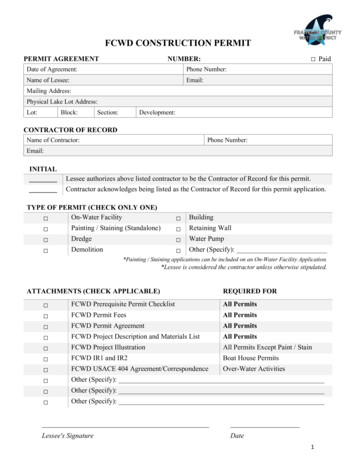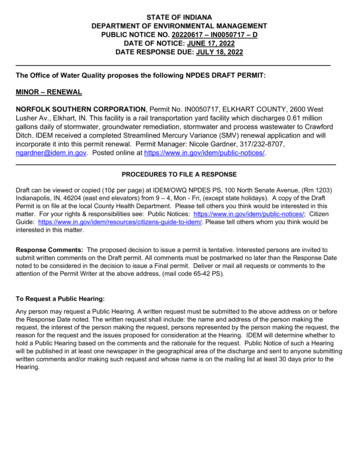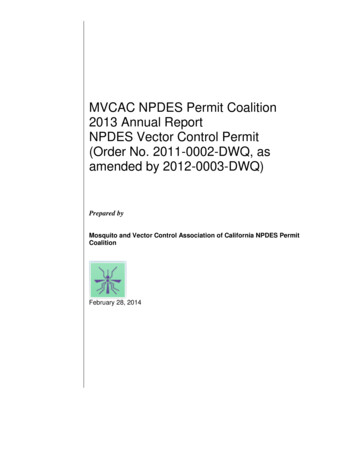
Transcription
MVCAC NPDES Permit Coalition2013 Annual ReportNPDES Vector Control Permit(Order No. 2011-0002-DWQ, asamended by 2012-0003-DWQ)Prepared byMosquito and Vector Control Association of California NPDES PermitCoalitionFebruary 28, 2014
TABLE OF CONTENTSExecutive Summary . ES-1Section 1Background Information . 11.11.2Section 2Summary of Monitoring Data. 12.12.22.3Section 3Prior Monitoring Activity .1Monitoring Activity in 2013 .3Discussion .4Best Management Practices . 13.13.23.3Section 4Introduction .1West Nile Virus Activity .2Vector Control Management Practices .1BMPs Currently in Use .1BMP Modifications .2Recomendations. 1TablesTable 1. Members of the MVCAC NPDES Permit CoalitionTable 2. MVCAC NPDES Permit Coalition Chemical Monitoring 2011 and 2012Table 3. MVCAC NPDES Permit Coalition Physical Measurements by Location, MPORARY INTERNET FILES\CONTENT.OUTLOOK\T9EJUDXC\MVCAC 2013 ANNUAL REPORT FINAL.DOCXi
Acronymsµg/Lmicrograms per literBMPsBest Management PracticesCoalitionMVCAC NPDES Permit CoalitionDOdissolved oxygenECelectrical conductivityIPMintegrated pest managementMADMosquito Abatement DistrictMRPMonitoring and Reporting ProgramMVCACMosquito and Vector Control Association of CaliforniaMVCDMosquito and Vector Control DistrictNPDESNational Pollutant Discharge Elimination SystemPAPPesticide Application PlanPBOpiperonyl butoxideSWRCBState Water Resources Control BoardVCDVector Control DistrictVCSDVector Control Services S\TEMPORARY INTERNET FILES\CONTENT.OUTLOOK\T9EJUDXC\MVCAC 2013 ANNUAL REPORT FINAL.DOCXii
EXECUTIVE SUMMARYThe Statewide National Pollutant Discharge Elimination System (NPDES) Permit for Biologicaland Residual Pesticide Discharges to Waters of the United States from Vector ControlApplications (Water Quality Order No. 2011-0002-DWQ; Vector Control Permit) becameeffective on November 1, 2011. This general permit was later amended by Water Quality OrderNo. 2012-0003-DWQ on April 3, 2012. The Vector Control Permit covers the point sourcedischarge of biological and residual pesticides resulting from direct and indirect sprayapplications for vector control. Under this general permit, entities involved in the application ofvector control pesticides that result in a discharge of biological and residual pesticides to watersof the United States are to comply with the permit’s Monitoring and Reporting Program (MRP).The permit encourages dischargers to form monitoring coalitions with others doing similarapplications in similar environmental settings. The Mosquito Vector Control Association ofCalifornia (MVCAC) NPDES Permit Coalition (Coalition) consists of 64 member districts andagencies. In 2011 and 2012, the Coalition conducted visual, physical, and chemical monitoringconsistent with its Monitoring Plan (dated September 12, 2011) and Quality Assurance ProjectPlan (dated September 12, 2011) which were developed to comply with the MRP from theVector Control Permit.During 2013, the Coalition did not conduct chemical monitoring or perform visual, physical, andchemical testing reportable under the Vector Control Permit. Chemical monitoring andassociated visual and physical monitoring were suspended due to ongoing negotiations with theState Water Resources Control Board (SWRCB). These discussions were centered on theremoval of the physical and chemical monitoring requirements in the permit. The SWRCB iscurrently proposing significant changes to the Vector Control Permit which have a direct impacton the monitoring component.MVCAC member agencies also suspended visual and physical monitoring during application oflarvicides. They did not document visual monitoring observations due to high West Nile virusactivity in 2013. This is consistent with the SWRCB notification letter of July 13, 2012 toMVCAC that because visual monitoring requirements were “interfering with the need formaximal efficient application to adequately protect human health from vector-borne diseases likeWest Nile virus,” that the visual monitoring was no longer required by individual memberdistricts. The member districts continued to follow the guidelines of its Pesticide ApplicationPlan (PAP).Improvements to individual district PAPs and their associated best management practices(BMPs) were determined by individual member districts during their annual reporting asrequired by the Vector Control \TEMPORARY INTERNET FILES\CONTENT.OUTLOOK\T9EJUDXC\MVCAC 2013 ANNUAL REPORT FINAL.DOCXES-1
SECTION 1BACKGROUND INFORMATION1.Section 1 ONEBackgrou nd Infor mat ion1.1INTRODUCTIONThis is the 2013 Annual Report for MVCAC NPDES Permit Coalition, as required under theStatewide NPDES Permit for Biological and Residual Pesticide Discharges to Waters of theUnited States from Vector Control Applications (Water Quality Order No. 2011-0002-DWQ, asamended by Water Quality Order No. 2012-0003-DWQ). The Coalition conducts chemicalmonitoring for its members under the Vector Control Permit MRP (Attachment C of the permit).Member districts of the Coalition submit individual annual reports consistent with the VectorControl Permit. Individual annual reports focus on larvicide and adulticide applications, sitelocations, and comprehensive pesticide applications logs for all larvicide and adulticideapplications to Waters of the United States. Member district annual reports also addressrecommendations to improve PAPs and BMPs. Members of the Coalition are listed in Table 1.Table 1. Members of the MVCAC NPDES Permit CoalitionAlameda County MADMerced County MADAlameda County VCSDNapa County MADBurney Basin MADNevada County Community Development AgencyButte County MVCDNorthern Salinas Valley MADCity of AlturasNorthwest MVCDCity of BlytheOrange County VCDCity of Long BeachOroville MADCity of MoorparkOwens Valley MADCity of PasadenaPine Grove MADCity of San FranciscoPlacer MVCDCoachella Valley MVCDRiverside County Vector Control ProgramColusa MADSacramento - Yolo MVCDCompton Creek MADSaddle Creek Community Services DistrictConsolidated MADSan Benito County Agricultural CommissionContra Costa MVCDSan Bernardino CountyDelta VCDSan Diego County Department of EnvironmentalHealth - Vector Control ProgramDurham MADSan Gabriel Valley MVCDEast Side MADSan Joaquin County MVCDEl Dorado County Environmental ManagementSan Mateo County MVCDFresno MVCDSanta Barbara County, Mosquito and VectorManagement District ofFresno Westside MADSanta Clara County VCDGlenn County MVCDSanta Cruz County MPORARY INTERNET FILES\CONTENT.OUTLOOK\T9EJUDXC\MVCAC 2013 ANNUAL REPORT FINAL.DOCX1
SECTION 1BACKGROUND INFORMATIONTable 1. Members of the MVCAC NPDES Permit CoalitionGreater Los Angeles County VCDShasta MVCDImperial County Vector ControlSolano County MADJune Lake Public Utility DistrictSouth Fork MADKern MVCDSutter-Yuba MVCDKings MADTehama County MVCDLake County VCDTulare County MADLos Angeles County West VCDTurlock MADMadera County MVCDVentura County Environmental Health DivisionMammoth Lakes MADWest Side MVCDMarin/Sonoma MVCDWest Valley MVCDNotes:MAD Mosquito Abatement DistrictMVCD Mosquito and Vector Control DistrictVCD Vector Control DistrictVCSD Vector Control Services District1.2WEST NILE VIRUS ACTIVITYWest Nile virus is a mosquito-borne disease that is common in Africa, west Asia, the MiddleEast, and more recently, North America. Human infection with West Nile virus may result inserious illness. It first appeared in California in 2002, and in 2004, West Nile virus activity wasobserved in all 58 counties.ArboNET is the Center for Disease Control’s internet-based passive surveillance system forarboviral diseases (including West Nile virus) in the United States. Data are uploaded toArboNET on a weekly basis by state and local health departments. In 2013, a total of 368 humancases of West Nile virus and 15 fatalities were reported to ArboNET. Based on Center forDisease Control studies, there were probably thousands of additional cases that were notdiagnosed or WS\TEMPORARY INTERNET FILES\CONTENT.OUTLOOK\T9EJUDXC\MVCAC 2013 ANNUAL REPORT FINAL.DOCX2
SECTION 2SUMMARY OF MONITORING DATA2.Section 2 TW OSumm ar y of M onitorin g Dat a2.1PRIOR MONITORING ACTIVITYThe Coalition conducted chemical monitoring at 61 locations during 19 adulticide applicationevents in 2011 and 2012 and performed the necessary visual, physical, and chemical testingreportable under the Vector Control Permit. The Coalition also coordinated physical monitoringfor 136 larvicide application events in 2012. MVCAC member agencies were in full compliancewith the monitoring requirements of the Vector Control Permit.Samples and measurements taken for the purpose of monitoring were representative of themonitored activity. They characterized aerial and truck applications, and covered a broadgeographic range. Visual observations included descriptions of the monitoring area, appearanceof the waterway, and weather conditions.Chemical monitoring by the Coalition included the adulticide active ingredients listed in theVector Control Permit. Table 2 illustrates the Coalition’s progress towards meeting the chemicalmonitoring requirements of the Vector Control Permit MRP. Concentrations of pyrethrins,permethrin, sumithrin, prallethrin, etofenprox, piperonyl butoxide (PBO), naled, and malathionwere analyzed and reported by the California Department of Fish and Wildlife Water PollutionControl Laboratory (Gold River, California) in 2011 and Caltest Analytical Laboratory (Napa,California) in 2012. In 2012, five application events of chemical pesticides, including malathion,PBO in PBO/pyrethrin mixtures, and etofenprox, resulted in exceedances of Receiving WaterLimitations or Receiving Water Monitoring Triggers. Several of the compounds were also foundin the pre-application event at concentrations greater than the monitoring trigger. Investigationsof these exceedances were conducted as required by the Vector Control Permit. No adverseeffects were witnessed.Table 2. MVCAC NPDES Permit Coalition Chemical Monitoring, 2011 and 2012AgriculturalActive \TEMPORARY INTERNET FILES\CONTENT.OUTLOOK\T9EJUDXC\MVCAC 2013 ANNUAL REPORT FINAL.DOCX1
SECTION 2TemephosSUMMARY OF MONITORING DATA606060The Coalition sampled 87 of the required 180 application events in 2011 and 2012 with themajority of those being five products (pyrethrin, PBO with pyrethrin, sumithrin, permethrin, andPBO). The other five products (resmethrin, PBO with resmethrin, prallethrin, etofenprox, andMGK 264) are rarely used and it is unlikely that sufficient uses would be available to completethe testing in the future.With the exception of PBO, the data collected in 2011 and 2012 had low detection frequencies.Active ingredients were detected in only 8 of 51 samples (16%) analyzed for pyrethrin,permethrin, sumithrin, or etofenprox. PBO was analyzed in 100 total samples because it wasapplied with all pyrethroids and PBO was detected above the method detection limit of 0.005µg/L in 63 (63%) of those samples. Detection frequencies are expected to be similar for activeingredients that were not sampled in 2011 and 2012, based on the similar nature of theapplications.Physical measurements (temperature, pH, electrical conductivity [EC], and dissolved oxygen[DO], and turbidity) for larvicide applications were coordinated by the Coalition. Physicalmeasurements collected in the field included temperature, pH, EC, and DO. Turbidity wasmeasured in the field or at a laboratory. Table 3 lists which districts collected physicalmeasurements for each larvicide active ingredient in 2012. Some of the representing districtscompleted their physical measurements in early-2013.Table 3. MVCAC NPDES Permit Coalition Physical Measurements, 2012Product NameBacillus sphaericusVectolex CG Biological LarvicideVectolex WDG Biological LarvicideVectolex WSP Biological LarvicideSpheratax SPH (50 G) WSPSpheratax SPH (50 G)Bacillus thuringiensisVectobac Technical PowderVectobac-12 ASAquabac 200GTeknar HP-DVectobac-G Biological Mosquito Larvicide GranulesAquabac xtBacillus sphaericus and Bacillus thurigensisVectomax CG Biological LarvicideVectomax WSP Biological LarvicideVectomax G Biological Larvicide/GranulesFourStar BriquetsFourStar SBGRegistrationNumberEnvironmental SettingRural/AgUrbanWetlandVolunteer District73049-2073049-5773049-2084268-284268-2San 2637-1Placer (6)3049-4293049-4293949-42983362-385685-1Lake County(6)Greater LASan Mateo (6)(6)Greater LA(6)Butte County(6)San Joaquin San Joaquin(2)(2)San Diego (4) San Diego PORARY INTERNET FILES\CONTENT.OUTLOOK\T9EJUDXC\MVCAC 2013 ANNUAL REPORT FINAL.DOCX2
SECTION 2SUMMARY OF MONITORING DATATable 3. MVCAC NPDES Permit Coalition Physical Measurements, 2012Product NameMethopreneZoecon Altosid PelletsZoecon Altosid PelletsZoecon Altosid Liquid Larvicide Mosquito GrowthRegulatorZoecon Altosid XR Entended Residual BriquetsZoecon Altosid Liquid Larvicide ConcentrateZoecon Altosid XR-GZoecon Altosid SBG Single Brood GranulePetroleum DistillatesMosquito Larvicide GB-1111BVA 2 Mosquito Larvicide OilBVA Spray 13Monomolecular FilmsAgnique MMF Mosquito Larvicide & PupicideAgnique MMF GRegistrationNumberEnvironmental SettingRural/AgUrbanWetlandShasta (6)Greater LA(6)Napa County(6)San Joaquin(6)Greater LA(6)Sac-Yolo 12724-4898329-7270589-155206-253263-28Sac-Yolo (3)Owens Valley Coachella (6) Coachella (6)53263-30(3)SpinosadsNatular 2ECNatular GNatular XRGNatular XRT8329-828329-808329-838329-84Coachella (6)Greater LA(6)Sac-Yolo (6)The MRP does not require assessment of visual observations or physical measurement data.However, a review of the results suggests that (with one exception) there are no differencesbetween background, event, and post-event samples that could not be explained by diurnalfactors or subjective observations by different field personnel. There is nothing to demonstratethat results of the physical monitoring differ from the normal variability that would occur at siteswith no applications. Moreover, many of the application and monitoring sites are in areas withpublic access and are therefore subject to impacts beyond the control of MVCAC memberdistricts. This is particularly true of sites in urban settings.2.2MONITORING ACTIVITY IN 2013During 2013, the Coalition did not conduct chemical monitoring or perform visual, physical, andchemical testing reportable under the Vector Control Permit. Chemical monitoring andassociated visual and physical monitoring were suspended due to ongoing negotiations with theSWRCB. These discussions were centered on the removal of the physical and chemicalmonitoring requirements in the permit. The SWRCB is currently proposing significant changesto the Vector Control Permit which have a direct impact on the monitoring component.MVCAC member agencies also suspended visual monitoring due to high West Nile virusactivity in 2013. This is consistent with the SWRCB notification letter of July 13, 2012 ORARY INTERNET FILES\CONTENT.OUTLOOK\T9EJUDXC\MVCAC 2013 ANNUAL REPORT FINAL.DOCX3
SECTION 2SUMMARY OF MONITORING DATAMVCAC that because visual monitoring requirements were “interfering with the need formaximal efficient application to adequately protect human health from vector-borne diseases likeWest Nile virus,” that the visual monitoring was no longer required by individual memberdistricts. The member districts continued to follow the guidelines of its PAP.2.3DISCUSSIONThe Coalition was formed to gather data to better understand how the activities of MVCACmembers and their application of pesticides affect the important goals of water quality. Theinitial concern regarding mosquito control products was the products used for adulticiding, asthese products are designed to target mosquitoes in the air. Adulticides treat a specific area withthe material drifting through an application zone, killing mosquitoes when they come in contactwith the product. It is understood that some of the material, if applied over waterways, couldcome in contact with the water. In contrast to adulticides, larval control applicationsimplemented by mosquito control districts are required by the Vector Control Permit to havevisual and physical monitoring only (aside from temephos) due to the recognition that theseproducts are highly specific to mosquito larvae and are widely accepted as excellent BMPs.The physical and chemical monitoring results contained in the 2011-2012 report indicate that theactive ingredient being sampled is rarely present in the waterway and/or the presence of thematerial in the waterway is of extremely short duration. Thus, there does not seem to be anysignificant long-term impact to the beneficial uses of the waters.The Coalition’s 2011-2012 annual report provided the following conclusions: 1 out of 136 visual observations showed a difference between background and post-eventsamples; 108 physical monitoring samples showed no difference between background and post-eventsamples; and 6 out of 112 samples exceeded the receiving water monitoring limitation or triggers.The report indicated that there was no significant impact to beneficial uses of receiving watersdue to application of vector control pesticides in accordance with approved application rates.This is consistent with the primary mandate for vector control districts of protecting public healthby reducing vector-borne diseases from mosquitos and other vectors.During the same time period, the University of California Davis, Department of EnvironmentalToxicology conducted the toxicity study for the SWRCB (in 2011 and 2012). University ofCalifornia Davis submitted the Draft General Pesticide Permit Toxicity Study Report to theSWRCB in December 2012. The draft report provided the following conclusions: 17 out of 106 (16 percent) samples were toxic, primarily due to dichlorvos which is adegradation by-product of the active ingredient naled; Other toxic samples could be due to the presence of other pyrethroids not used in vectorcontrol applications and piperonyl butoxide, which synergized pyrethroids already in thewater or sediments; Chemical monitoring can be used in lieu of toxicity testing to determine compliance with OWS\TEMPORARY INTERNET FILES\CONTENT.OUTLOOK\T9EJUDXC\MVCAC 2013 ANNUAL REPORT FINAL.DOCX4
SECTION 2 SUMMARY OF MONITORING DATAAlthough the toxicity study showed some toxicity resulted from vector control applications,the incidence of toxicity was found not to be significant.For all the above reasons, further chemical testing is not likely to result in identification of anynew information or any environmentally beneficial improvements to water quality and thereforechemical testing was not performed in EMPORARY INTERNET FILES\CONTENT.OUTLOOK\T9EJUDXC\MVCAC 2013 ANNUAL REPORT FINAL.DOCX5
SECTION 3BEST MANAGEMENT PRACTICES3.Sec tion 3 THR EEBes t M anagement Practic es3.1VECTOR CONTROL MANAGEMENT PRACTICESMVCAC member agencies employ integrated pest management (IPM) and thus use ofadulticides to control adult mosquitos is the method of control when it becomes necessary, suchas in the event of a disease outbreak (documented presence of infectious virus in active hostseeking adult mosquitoes), or lack of access to larval sources leading to the emergence of largenumbers of adult mosquitoes. First and foremost, MVCAC promotes education to prevent theformation of mosquito habitat. To that end, MVCAC encourages all public agencies toincorporate the California Department of Public Health BMPs in their planning and permittingdocuments and requirements. More than any other collective action that MVCAC could take;educating landowners about the simple, low-cost ways to prevent mosquito breeding habitatswill have the greatest effects on disease prevention. This step alone has the greatest potential toreduce the need for adulticides. While MVCAC presses for introduction of these education andinformation tools throughout the state, its second level of protection is the use of physical andbiological control tools to reduce the potential formation of mosquito breeding sites. Such stepsinclude the use of water management practices, the removal of vegetation, and the introductionof predacious organisms such as mosquito fish to control the mosquito populations in theiraquatic stage. Many districts conduct surveillance to ensure that they are targeting only thosemosquitoes with the greatest impact to public health and this surveillance component helps drivecontrol efforts. The third and fourth steps in the IPM process are chemical control ofmosquitoes using larvicides and adulticides.3.2BMPS CURRENTLY IN USEMember districts of MVCAC implement the BMPs provided in their respective PAPs in meetingthe requirements of the Vector Control Permit. MVCAC member agencies follow an IPMapproach that strives to efficaciously use pesticides and minimize their impact on theenvironment while protecting public health. Each member agency determines what vectormanagement methods are appropriate in their district, and follows response plans that usesurveillance tools to determine the extent of the problem and guide treatment decisions, with anemphasis on source reduction and control of mosquitoes in their immature stages. The least toxicmaterials available for control of the larval stages, focusing on bacterial larvicides, growthregulators and surface films are used rather than organophosphates or pyrethroids. Control ofadult mosquitoes may become necessary under some circumstances, such as in the event of adisease outbreak (documented presence of infectious virus in birds, human population or activehost-seeking adult mosquitoes), or lack of access to larval sources leading to the emergence oflarge numbers of biting adult mosquitoes. Organophosphate insecticides (naled and malathion)are used in rotation with pyrethrins or pyrethroids to avoid the development of resistance. Theactive ingredients currently used for control of adult mosquitoes have been deliberately selectedfor lack of persistence and minimal effects on non-target organisms when applied at label ratesfor ultra-low volume mosquito control. All BMPs included in the product labels are followed andinclude such measures as restrictions in certain land uses and weather (i.e., wind speed)parameters. Additional information about specific BMPs by region can be found in memberagency’s EMPORARY INTERNET FILES\CONTENT.OUTLOOK\T9EJUDXC\MVCAC 2013 ANNUAL REPORT FINAL.DOCX1
SECTION 33.3BEST MANAGEMENT PRACTICESBMP MODIFICATIONSModifications to BMPs are handled by individual member districts on a district-by-district basis.Any modifications to BMPs can be found in respective member districts annual reports preparedas required by the Vector Control Permit. Pesticide application logs and site locations of theapplications are also reported by the member districts in the district’s annual report.3.4VIOLATIONSIndividual member districts would report violations of the Vector Control Permit in the district’sannual report. No adverse impacts were reported to the OWS\TEMPORARY INTERNET FILES\CONTENT.OUTLOOK\T9EJUDXC\MVCAC 2013 ANNUAL REPORT FINAL.DOCX2
SECTION 44.Sec tion 4 F OURRECOMMENDATIONSRecomendati onsThe Vector Control Permit contains provisions for reducing monitoring and reportingrequirements, if certain conditions are met. On May 22, 2013, MVCAC requested a reduction ofthe monitoring requirements and SWRCB consideration of requirements that complement thevector control districts’ public safety mission and that do not interfere with the timing of theircritical pesticide applications.On December 31, 2013, the SWRCB issued an amended draft MRP for the Vector ControlPermit. Based on the 2011-2012 monitoring data, the SWRCB found that application ofpesticides in accordance with approved application rates does not impact beneficial uses ofreceiving waters, continuation of the existing monitoring requirements provides redundantinformation, and that continuing the prior monitoring regime is unnecessary.The SWRCB concluded that visual observations, monitoring and reporting of pesticideapplication rates, and reporting of non-compliant applications provide information that isequivalent to the existing monitoring and reporting requirements in determining compliance withthe Vector Control Permit. Therefore, the visual, physical, and chemical monitoring would bereplaced with reporting of visual observations, monitoring and reporting of application rates, andreporting of non-compliant applications.MVCAC and member agencies are currently in the process of responding to the draft amendmentto the Vector Control Permit MRP. This process should help finalize monitoring and reportingrequirements for EMPORARY INTERNET FILES\CONTENT.OUTLOOK\T9EJUDXC\MVCAC 2013 ANNUAL REPORT FINAL.DOCX1
SECTION T\WINDOWS\TEMPORARY INTERNET FILES\CONTENT.OUTLOOK\T9EJUDXC\MVCAC 2013 ANNUAL REPORTFINAL.DOCX2
Mosquito and Vector Control Association of California NPDES Permit Coalition February 28, 2014. TABLE OF CONTENTS . Contra Costa MVCD San Bernardino County Delta VCD San Diego County Department of Environmental Health - Vector Control Program Durham MAD San Gabriel Valley MVCD
